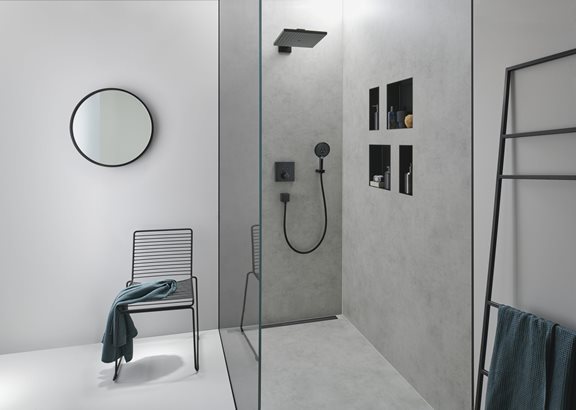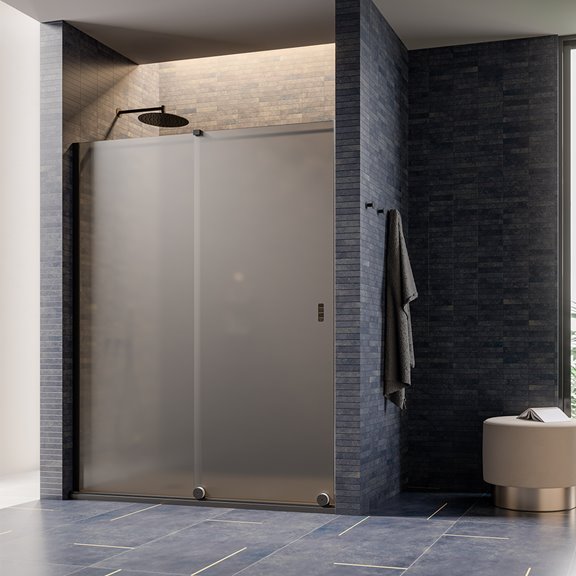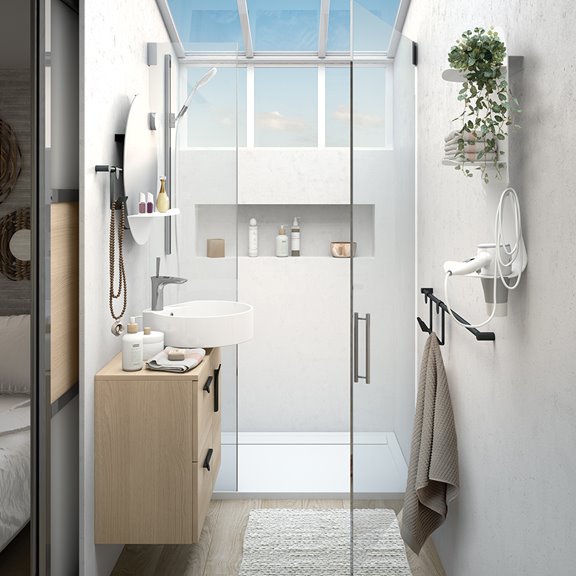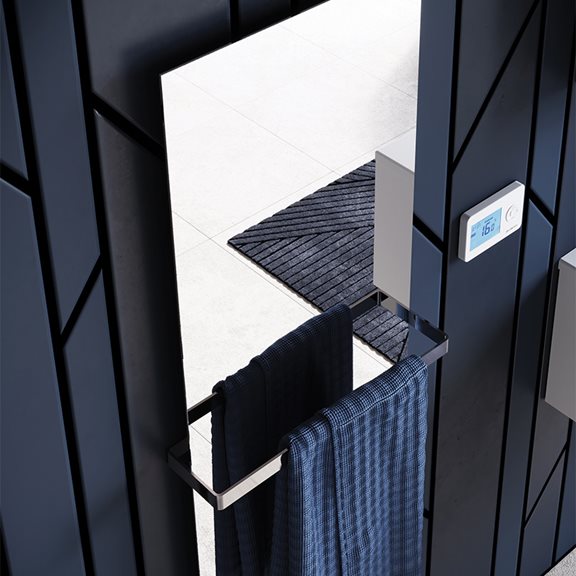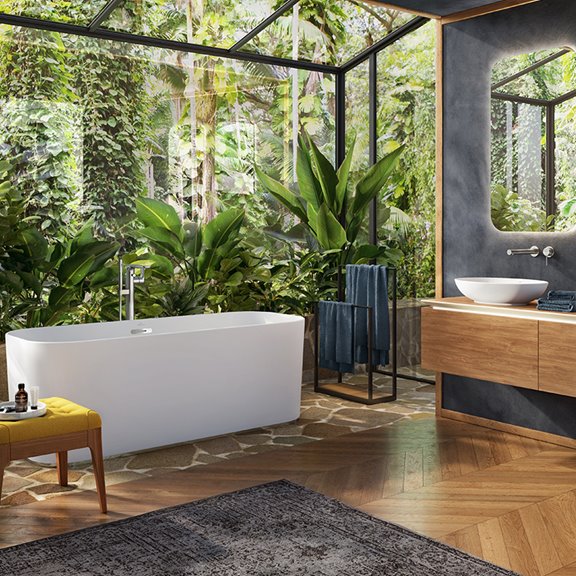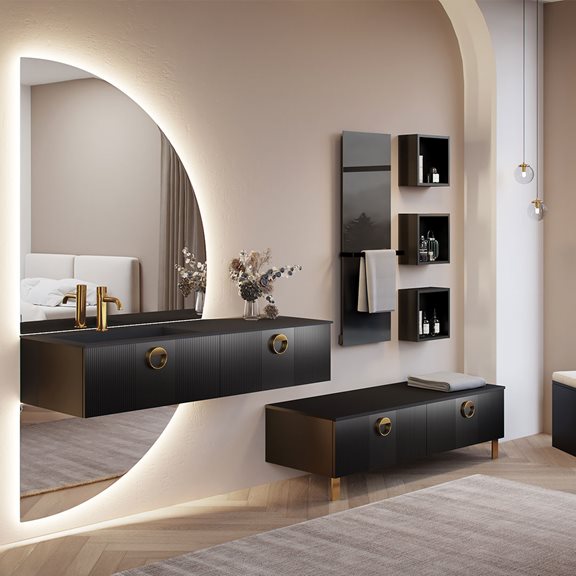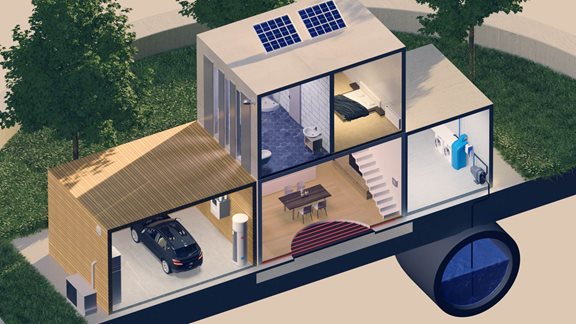10 tips to design a small bathroom
From fittings to furniture and accessories as well as finding the right colour, discover how you can design a small bathroom that is very comfortable.
10 tips to design a small bathroom
Are you having your home built or renovated? Maybe the space available for the bathroom is fairly small or very small? Here are 10 tips for smart ways to make the most of every cubic centimetre of this room, where your well-being comes first.
1. Choose the right equipment
In Belgium, many bathrooms measure less than six square metres. Moreover, if you are renovating, you may not even be able to completely change the layout in order to save space. For example, water inlets and outlets will automatically determine the location of the bathtub, washbasin, WC, and so on. It makes good sense to take these technical constraints into account, when choosing the bathroom fittings for your new home.
Bathtub or shower?
A shower takes up less space than a bathtub, it goes without saying. Especially if it is a walk-in (Italian) shower: this has no shower cubicle, or even a shower tray in some cases, just a wide-open shower, with no obstacles to overcome; plus a simple glass wall to prevent water from splashing into the rest of the bathroom.
Perhaps you enjoy a shower in the morning, but also like taking a bath from time to time. The good news is that there are also compact bathtubs – from 100 to 150 cm long. Other bathtubs are available in shapes that allow easy installation, including in spaces that are narrow or irregularly shaped, such as corner, semi-angle, asymmetric, or trapezoidal bathtubs, etc.
Moreover, you can opt for a bathtub in which you can also take a shower! Thanks to a matte, textured or non-slip coating, you can safely take either a bath or shower there.
2. Save space
To avoid taking up too much space and ensure easy movement around your small bathroom, especially if there are several of you in the room at the same time, choose sliding or folding doors. Opt for a folding shower door, if you have chosen a shower cubicle. And for the bath, go for a bathtub screen that has a fixed part and a sliding part, rather than pivoting outwards.
The washbasin or basin
Here, you can relax, because there is a wide choice: free-standing, integrated, semi-integrated, supplied with a piece of furniture, installed on a pedestal, a simple countertop or even a slim steel base, etc. The washbasin and basin are accessories that come in a multitude of formats (some mini-washbasins are only 20 to 25 cm deep), shapes (oval, round, rectangular, angular, asymmetric, etc.), and materials (ceramic, natural stone, marble, glass, composite materials, etc.).
You can also save space by having a washbasin unit fitted with a small siphon, and a wall-mounted tap with a short spout, which is more suitable for small spaces.
3. Opt for transparency
Let’s look again at the equipment to avoid water splashes. Our advice here is to go for a transparent material, with a bathtub screen made of glass or a walk-in shower panel made of glass. Our eyes will not see any obstacles, enabling us to view the whole space immediately.
If privacy is a goal, here is an idea for your glass panel: you can decorate it with an attractive screen print or opaque strips placed at half height. You could also seek a compromise, with translucent glass (which allows light to pass through, but partly obscures what is behind the panel) or slightly tinted glass.
A large (larger) window
For a new build or renovation, if your bathroom has a front wall, then installing the largest possible window will also bring in more light. But what if this window overlooks another building? In that case, you can use frosted glass or a thin net curtain that you only need to draw when someone is in the bathroom, to ensure your privacy.
4. Declutter the room
Obviously, a place full of all kinds of objects, including on the ground, does not look very nice. Another downside to clutter is that it makes the room look smaller. However, if everything is neatly stored and the space is clear, you will quickly feel as though you can breathe easy. This is a vital sensation in a bathroom, which should really be a place where the body and mind can find peace and serenity.
Wall-mounting
In a small bathroom, it can be useful to hang objects on a wall, including accessories and furniture. For instance, you can add items like hooks, towel holders, a wall-mounted toilet or a wall-mounted washbasin. The ‘hanging’ aspect will create a sense of lightness and make your bathroom look neat and tidy, as it will be far easier to clean. Please note, if you choose towel holders, these integrated accessories also let you add shower panels!
5. The art of minimalism
In line with the previous advice, small rooms look best with a minimalist style. So you can tidy up as much possible, but avoid filling your bathroom with lots of different storage units! It’s better to go for a single high column cabinet that is fairly narrow, and to choose between a washbasin and wall cabinet. Your selection of furniture should be guided by the goal of ensuring easy and free movement in the room.
One radiator, two functions
You can also replace hooks and towel holders with a towel radiator. You can hang your bath linen on it, and this type of heating is often enough for a small bathroom, which is easier to heat than a large room. So a towel heater is a good idea and a benefit worth highlighting! Nowadays, you can find towel radiator models in every size, almost any colour and all styles – traditional, design, or even highly original.
Less is more
When decorating, don’t overdo it. Avoid too many items and objects, even if they are attractive or nice, if they serve little purpose. The golden rule here is ‘less is more’. So you should focus on simplicity and clarity, aiming for a design that is both attractive and appropriate.
6. A protective cocoon
Besides the easy heating that we just mentioned, a small bathroom has another key advantage: it enables you to create a genuine cocoon, a space that is warm and cosy, and one where you will feel safe. This is very different from a large bathroom, which can pose a puzzle for some people. They wonder which accessories they should get to ‘fill’ such a vast and empty space, while seeking to create a cosy place that is also charming.
Nature, a gentle friend
This cosy and protective ambience can be created by using natural materials such as wood, wicker, terracotta, jute and rattan. Taps can be in brass, and the bath linen will ideally be made of linen and cotton. Add a green plant to the bathroom – selected from a species that thrives in humid environments and/or a plant that cleans the air – and your tranquillity bubble will be complete!
7. Let there be light!
If your bathroom is gloomy, it will feel more like a damp cave, a place where you won’t really want to set foot. Even if the room lacks a window, you can let the light in by using various light sources. You can install these in the ceiling above the bath, walk-in shower, washbasin, around the mirror, and so on.
Two lighting tips
- Functional lighting and ambient lighting are two different things. Around the mirror, lights should be white, neutral or even cold (over 4000° Kelvin), as this will make it easier to shave, put on or remove makeup, etc. However, lighting that is slightly more yellow and warm (3000 to 3500° Kelvin) may be more suitable if you enjoy creating a lounge ambience for relaxing moments, such as taking your bath. Another solution is to use a light dimmer, which can create either a subdued atmosphere or invigorating lights.
- Comply with the safety standards, which seek to limit any contact between water and electric parts: mount low-voltage spotlights into the ceiling at a height of over 2.25 m above the bottom of the bathtub or the shower tray/floor, and install the lighting above a circle that is 60 cm in diameter around the washbasin.
8. Colour your oasis
Light colours will also help to add light to your bathroom and create the impression of making it look bigger. They will also help to make your bathroom timeless, so you won’t quickly grew tired of the room.
Apply everywhere the same plain colour, or two shades – three at most – from the same chromatic range. The best colours are to be found in pastel hues (light blue, sea green, pale yellow, greyish brown, etc.), shades of white, beige, ivory or the colour ‘nude’ – a whole palette of delicate varieties of pink, pale, peach, powder, rosewood, etc.
A sparkling touch
These rather neutral tones may later feel rather monotonous or boring. If so, you can always add a personal touch with an accessory, decoration or even an unusual or amusing object in a bright colour (we suggest red, blue, green or golden), something to catch the eye.
Why a plain and uniform colour?
If your walls are crossed by brightly coloured stripes and veins in a marble look, for example, you will achieve the opposite effect to the one you first aimed for. Because the walls will appear to be overloaded and smaller, as if you had painted them in a dark colour. So it is better to save this marbling skill (because you will definitely need some skill to successfully achieve this effect) for large bathrooms.
9. Create an illusion
There is a very simple way to extend space and to create the impression of moving around a room that feels much bigger than it actually is. Use a mirror. The bigger the mirror, the better this illusion will be.
You can add a huge mirror, extending from the splash panel of your washbasin up to the ceiling. Or do this horizontally, with a mirror that covers all the wall around the bathtub. Another possibility: place a mirror around the shower. This has two advantages: nobody can see through it (you can take a shower in privacy) and when you stand outside the shower, you can see how you look from head to toe. This is handy when you want to adjust your clothes or outfit.
Hall of mirrors
Here’s another magical trick: two mirrors facing each other will make the room seem even larger. If you bathroom has a window, you can place the mirrors on the opposite side, as in the Hall of Mirrors in the Château de Versailles! Of course that is a state room 10.5 metres wide. But by reflecting the light and greenery in the gardens, its mirrors further reinforce the perspective and luminosity.
To make your bathroom feel larger, you can also cover the walls and floor with large tiles. Big tiles are available in many kinds of materials, from travertine to concrete, including terracotta, natural stone, slate or even terrazzo (also known as granito).
Terrazzo not only looks elegant, it is a form of tiling that is easy to maintain, as it has fewer joints. These are places where dirt, mould and bacteria often build up, so you will want to quickly get rid of these undesirables.
10. Good ventilation
We have talked a lot here about having the right fittings, to create a small bathroom with maximum comfort. The furniture, sanitary fittings, lighting, colours, and coverings of the floor and walls all play a key role here. But something else should not be forgotten, as it is important for your comfort and health: ventilation. To ensure the atmosphere stays perfectly healthy in a room that often gets damp, it is essential to remove the stale air and to replace it with fresh air.
Different types of ventilation
You can choose from several systems:
- Air extractor: easy to install, this evacuates the room’s air to the outside. However, this extractor does not bring in fresh air. This device is the cheapest and uses the least energy.
- Single flow CMV (Controlled Mechanical Ventilation), also called system C: it includes ventilators that extract the polluted air plus air extractors or adjustable grilles fixed on the window or above the door, to being in fresh air from outside. This is a good system for renovations.
- Double flow CMV or system D: recommended for new buildings, this system offers air extraction and supply functions, as well as filtering of particles present in the outside air, before this air reaches your bathroom. This is the last word in ventilation.
Have these tips inspired you? Visit one of our showrooms to get a better idea of the various possibilities mentioned, as well as to touch, see, measure, and compare our range of sanitary fittings and accessories. You will be able to make the most of your visit by asking questions to our experts. They will be delighted to share all their knowledge and to help with your design project for your small bathroom.
Book an appointment for bespoke advice!
Our experts are here to help you make the best choices.
Keep up to date
News, trends and special offers...
Subscribe to our monthly newsletter

